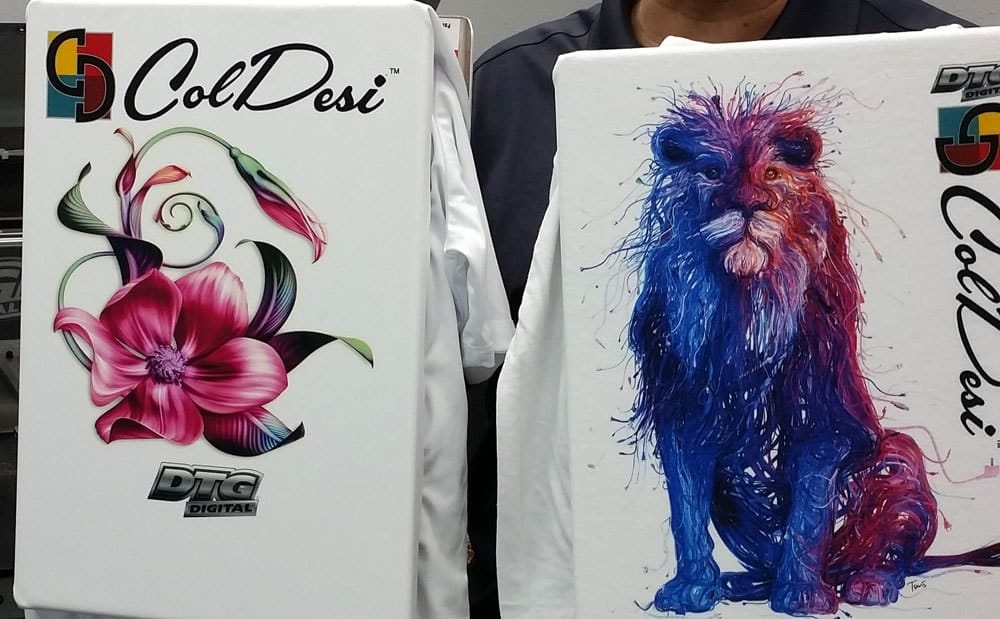T-Shirt Sublimation Blanks Printing vs Direct to Garment
COMPARING T-SHIRT PRINTING ON SUBLIMATION BLANKS TO DIRECT TO GARMENT (DTG)
Printing on sublimation blanks is an extremely common t-shirt printing method across the globe.
It’s the least expensive to get into for the most basic level of printing. Also, the prints can look amazing if it’s done right and it works well making other promotional products as well.
If you’ve seen t-shirts or other types of garments printed with an all over printer it was likely done with sublimation.
Direct to Garment Printing on T-Shirt Blanks
Even though direct to garment (dtg t-shirt printing machines) will cost more up front, you’ll spend about half as much on ink and supplies.
Have you ever ordered a custom t-shirt online from a company like Zazzle or Café Press or Ooshirts?
If so, there’s a 99.9% chance (yes, I made that statistic up on the spot..) that it was done with a direct to garment printer of some kind. Those companies purchase a lot of direct to garment printers specifically because the ability to create beautiful shirts on a one-off basis is exactly where DTG shines.
And of course, the more options you can offer your customers, the more successful your t-shirt business can be.
Let’s break down the processes so you can compare.

The Science Behind Printing Sublimation Blanks
There’s a little science behind these two printing methods. Here’s the short description of how sublimation printing on t-shirt blanks works:
You use what is often a standard color inkjet printer with sublimation inks instead of the printing inks. And print the image you want to apply to a t-shirt onto a special sublimation paper.
Sublimation inks are made so when you apply heat, they turn into a gas. When the inks are in gaseous form, they automatically want to bond on a molecular level to whatever plastic/polymer is nearby.
This is also why we use pressure. The pressure keeps the sublimation blank t-shirt and the sublimation print very close to each other and connected during this phase.
Next, the image transfers onto the plastic very tightly and it typically cannot be washed off or removed because when the gas bonds to the plastic, it becomes a solid and remains part of the sublimation blank
The Downside to Sublimation T-Shirt Printing
There’s no white ink!
Imagine you’re about to paint a black or dark blue wall with a lighter color, like yellow.
What happens when you just walk up to the wall with a roller full of bright yellow paint and put it on the wall? You end up with a gross, dull, dingy yellowish mess on the wall.
Solution: You prime the wall with white first. Then paint the yellow. This way you get the color you wanted.
Since there’s no white ink in sublimation t-shirt printing if you try and print on a dark shirt you get the dingy yellowish mess. No good.
Another downside is that you can only print on polyester. Better if it’s 100% polyester shirts.
No cotton shirts, period. Blends are tough too because you’ll end up with dull print depending on how much polyester is in the blend.
Size matters.
The truth is that almost all of those all over prints you see on the market were done when the shirt was manufactured. The printed right on the material before or after cutting the shape.
Because the inexpensive sublimation printer setups are small – usually 8.5” X 11” or so. You can print all-over very tiny t-shirts.


Direct to Garment T-Shirt Printing Machines
Direct to garment printers are specially built inkjet printers for traditional cotton and blend t-shirts.
They use an eco-friendly water-based ink that is jetted directly on the surface of the shirt. Remember, the sublimation printer makes a kind of paper transfer that you then apply to the garment. With DTG you put the shirt(s) right into the printer.
Typically, you will pretreat the shirt before and, and when you’re done printing you can either heat press it to set the ink or send it through a tunnel dryer if you’re a bigger operation.
DTG printers are commercial equipment designed to be RELIABLE and for heavy duty use. One of the reasons that it’s pricier than an entry level set up for sublimation t-shirts.
Using the G4 DTG Printer as an example, the standard image size you can print is a lot bigger too. That 8.5″x11” size we talked about before? Small. The G4 will print up to 16″ x 20″!
A great business is one that can offer their customers choices and be able to print great on bigger shirts is a “big” choice to offer.
The Upside to Direct to Garment T-Shirt Printing
There IS white ink, unlike printing on sublimation blanks
You get to print AMAZING quality images on dark garments. There are a few pictures here so you can see how crazy good they are. You can do that because modern direct to garment printers come with white ink capabilities built in.
Printing on cotton is the sweet spot for DTG. Unlike sublimation, direct to garment was made to print on natural fibers. 100% ring spun cotton is the best shirt to print on.
You can print on all sorts of garment types not just white polyester t-shirt sublimation blanks:
- Print on dark garments
- Cotton t-shirt printing
- Polyester t-shirt printing
Here’s a link showing all the types of plain t-shirt blanks you can print on with DTG.
Just like sublimation, dtg printers can make some amazing, vibrant prints on white 100% polyester shirts. Amazing ones.
But just like sublimation, it has a hard time with some blended fabrics. The difference is that when you print on blends with DTG they will LOOK amazing, they just don’t wash as well.
You can print on blends, but you’ll need to test different shirts yourself


Conclusion: Which is Better?
There are good reasons to adopt each technology, and many people don’t even choose. They get one of each!
There are good leasing programs available with direct to garment t-shirt printing machines, so if you can only get one, check those out. They have the winning features and advantages including:
- 50% lower ink cost per shirt. Even if you only spend an extra $.50 per shirt it doesn’t take many sales to pay for the difference in upfront costs. Or to make your equipment lease payment.
- Printing on Cotton AND Polyester. Game changer for your business. The big online companies have made their choice in favor of DTG. One reason is that you can print on more clothing items. Printing on more = making more customers.
- Bigger Prints. The G4 print can print up to 16” x 20”. That larger print size means you can offer larger graphics on larger shirts and just serve more people. Serving more people = a better business.



